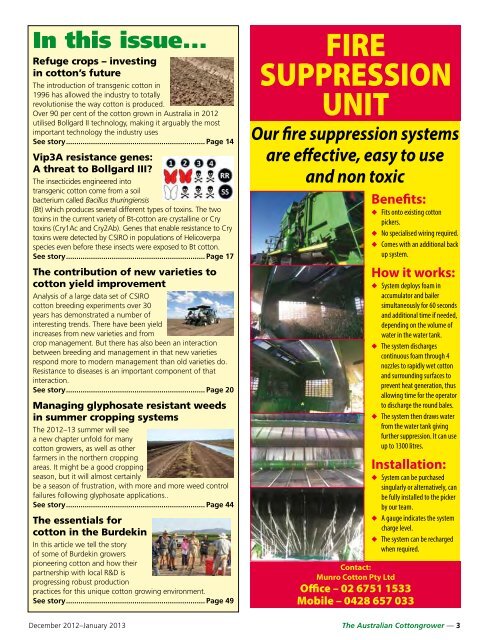cotton - Greenmount Press
cotton - Greenmount Press
cotton - Greenmount Press
You also want an ePaper? Increase the reach of your titles
YUMPU automatically turns print PDFs into web optimized ePapers that Google loves.
In this issue...<br />
Refuge crops – investing<br />
in <strong>cotton</strong>’s future<br />
The introduction of transgenic <strong>cotton</strong> in<br />
1996 has allowed the industry to totally<br />
revolutionise the way <strong>cotton</strong> is produced.<br />
Over 90 per cent of the <strong>cotton</strong> grown in Australia in 2012<br />
utilised Bollgard II technology, making it arguably the most<br />
important technology the industry uses<br />
See story................................................................... Page 14<br />
Vip3A resistance genes:<br />
A threat to Bollgard III<br />
The insecticides engineered into<br />
transgenic <strong>cotton</strong> come from a soil<br />
bacterium called Bacillus thuringiensis<br />
(Bt) which produces several different types of toxins. The two<br />
toxins in the current variety of Bt-<strong>cotton</strong> are crystalline or Cry<br />
toxins (Cry1Ac and Cry2Ab). Genes that enable resistance to Cry<br />
toxins were detected by CSIRO in populations of Helicoverpa<br />
species even before these insects were exposed to Bt <strong>cotton</strong>.<br />
See story................................................................... Page 17<br />
The contribution of new varieties to<br />
<strong>cotton</strong> yield improvement<br />
Analysis of a large data set of CSIRO<br />
<strong>cotton</strong> breeding experiments over 30<br />
years has demonstrated a number of<br />
interesting trends. There have been yield<br />
increases from new varieties and from<br />
crop management. But there has also been an interaction<br />
between breeding and management in that new varieties<br />
respond more to modern management than old varieties do.<br />
Resistance to diseases is an important component of that<br />
interaction.<br />
See story................................................................... Page 20<br />
Managing glyphosate resistant weeds<br />
in summer cropping systems<br />
The 2012–13 summer will see<br />
a new chapter unfold for many<br />
<strong>cotton</strong> growers, as well as other<br />
farmers in the northern cropping<br />
areas. It might be a good cropping<br />
season, but it will almost certainly<br />
be a season of frustration, with more and more weed control<br />
failures following glyphosate applications..<br />
See story................................................................... Page 44<br />
The essentials for<br />
<strong>cotton</strong> in the Burdekin<br />
In this article we tell the story<br />
of some of Burdekin growers<br />
pioneering <strong>cotton</strong> and how their<br />
partnership with local R&D is<br />
progressing robust production <br />
practices for this unique <strong>cotton</strong> growing environment.<br />
See story................................................................... Page 49<br />
FIRE<br />
SUPPRESSION<br />
UNIT<br />
Our fire suppression systems<br />
are effective, easy to use<br />
and non toxic<br />
Benefits:<br />
u Fits onto existing <strong>cotton</strong><br />
pickers.<br />
u No specialised wiring required.<br />
u Comes with an additional back<br />
up system.<br />
How it works:<br />
u System deploys foam in<br />
accumulator and bailer<br />
simultaneously for 60 seconds<br />
and additional time if needed,<br />
depending on the volume of<br />
water in the water tank.<br />
u The system discharges<br />
continuous foam through 4<br />
nozzles to rapidly wet <strong>cotton</strong><br />
and surrounding surfaces to<br />
prevent heat generation, thus<br />
allowing time for the operator<br />
to discharge the round bales.<br />
u The system then draws water<br />
from the water tank giving<br />
further suppression. It can use<br />
up to 1300 litres.<br />
Installation:<br />
u System can be purchased<br />
singularly or alternatively, can<br />
be fully installed to the picker<br />
by our team.<br />
u A gauge indicates the system<br />
charge level.<br />
u The system can be recharged<br />
when required.<br />
Contact:<br />
Munro Cotton Pty Ltd<br />
Office – 02 6751 1533<br />
Mobile – 0428 657 033<br />
December 2012–January 2013 The Australian Cottongrower — 3

















